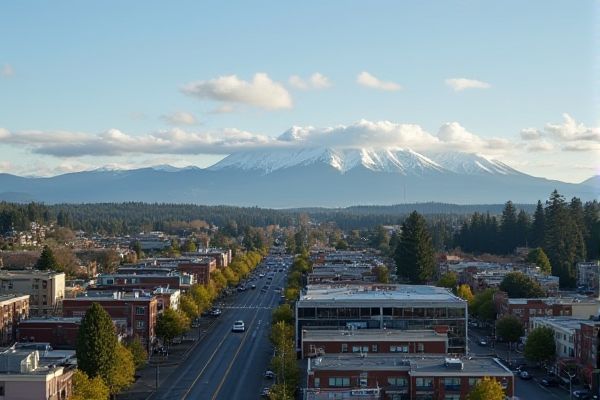
Transportation and commuting in Oregon: Oregon Transit Tax. Regional transit systems. Portland's extensive MAX Light Rail. Bikeshare programs. Carpooling incentives. Interstate Amtrak routes. Regional park-and-ride lots. E-scooter rentals. Oregon Scenic Byways. Electric vehicle charging stations.
Oregon Transit Tax
The Oregon Statewide Transit Tax is a payroll tax where employers must withhold 0.10% (0.001) from each employee's wages. It applies to both Oregon residents and nonresidents working in the state, with the revenue channeled into the Statewide Transportation Improvement Fund to finance public transportation improvements.
Regional transit systems
In Oregon, particularly in the Portland area, the regional transit system includes TriMet buses, MAX Light Rail with five lines (Blue, Red, Green, Yellow, and Orange), Portland Streetcar, and the Portland Aerial Tram. These systems provide frequent and accessible service, connecting the city, suburbs, and key destinations like the airport and Washington Park, with tools like trip planners and mobile apps to facilitate travel.
Portland's extensive MAX Light Rail
Portland's MAX Light Rail is a comprehensive public transportation system with five lines (Blue, Green, Red, Yellow, and Orange) connecting the city, airport, and surrounding suburbs. It offers nearly 100 stations and 60 miles of track, with trains running every 15 minutes and fares starting at $2.80 for a 2.5-hour ride. For more detailed information, you can visit the Travel Portland website.
Bikeshare programs
In Oregon, particularly in Portland, the BIKETOWN bike share program offers a comprehensive and inclusive transportation option. It includes a standard bike share system with 1,500 e-bikes and 232 stations, as well as the "BIKETOWN for All" program, which provides discounted memberships and free unlocks for low-income residents, promoting equity and accessibility in cycling.
Carpooling incentives
In Oregon, carpooling incentives include priority parking space assignments, reduced monthly permit rates for carpools with at least two employees, and semi-annual certifications to maintain these benefits, particularly for state employees working in designated areas such as Salem, Eugene, the Lloyd District, and Downtown Portland. Additionally, the City of Portland offers incentives like discounted parking, transit passes, and additional monthly income for carpoolers, walkers, and bikers through its TRIP Program.
Interstate Amtrak routes
Oregon has seven Amtrak stations served by the Amtrak Cascades, Coast Starlight, and Empire Builder routes. These routes connect cities such as Portland, Eugene, and Salem, with the Cascades offering regional service to Seattle and Vancouver, and the Coast Starlight linking to California and other West Coast destinations. For more detailed information about these stations, you can visit the Amtrak Guide website.
Regional park-and-ride lots
Regional park-and-ride lots in Oregon are designated parking areas where drivers can park their vehicles and access various transportation options, including public transit, bike share, and carpool or vanpool services. These lots, managed locally, offer features such as ADA parking and electric vehicle charging stations, and can be located and utilized through the Get There Connect tool.
E-scooter rentals
In Portland, Oregon, e-scooter rentals are a convenient and popular mode of transportation available through companies such as Lime and Biketown. To begin a ride, users need to download the respective app, locate a scooter, and scan the QR code to activate it. As highlighted on the Travel Portland website, riders must adhere to specific guidelines, including wearing helmets, yielding to pedestrians, avoiding sidewalks, using bike lanes, and ensuring that the scooter is securely locked to a public bike rack or signpost after use. This system not only promotes safety but also encourages responsible usage among riders.
Oregon Scenic Byways
The Scenic Byways Program in Oregon is a captivating initiative managed by the Oregon Department of Transportation and brilliantly marketed by Travel Oregon. This program highlights 29 designated routes that proudly showcase the state's breathtaking natural beauty, intriguing historical sites, and vibrant cultural attractions. These routes not only generate significant local tourism revenue but also enhance Oregon's scenic, historical, and recreational qualities. For more information, visit the Oregon Scenic Byways webpage to embark on your journey through these magnificent landscapes.
Electric vehicle charging stations
Oregon boasts an impressive network of over 3,200 public EV charging ports and 1,250 public charging stations. Among these are more than 1,000 Level 2 chargers and 270 DC Fast stations, ensuring that electric vehicle drivers have the resources they need for convenient travel. The state has made significant investments in rural areas and along major highways, such as the West Coast Electric Highway, to enhance accessibility and support sustainable transportation. For more detailed information about the state's charging network, visit the Qmerit website. These initiatives highlight Oregon's commitment to a greener future by facilitating the transition to electric vehicles.
